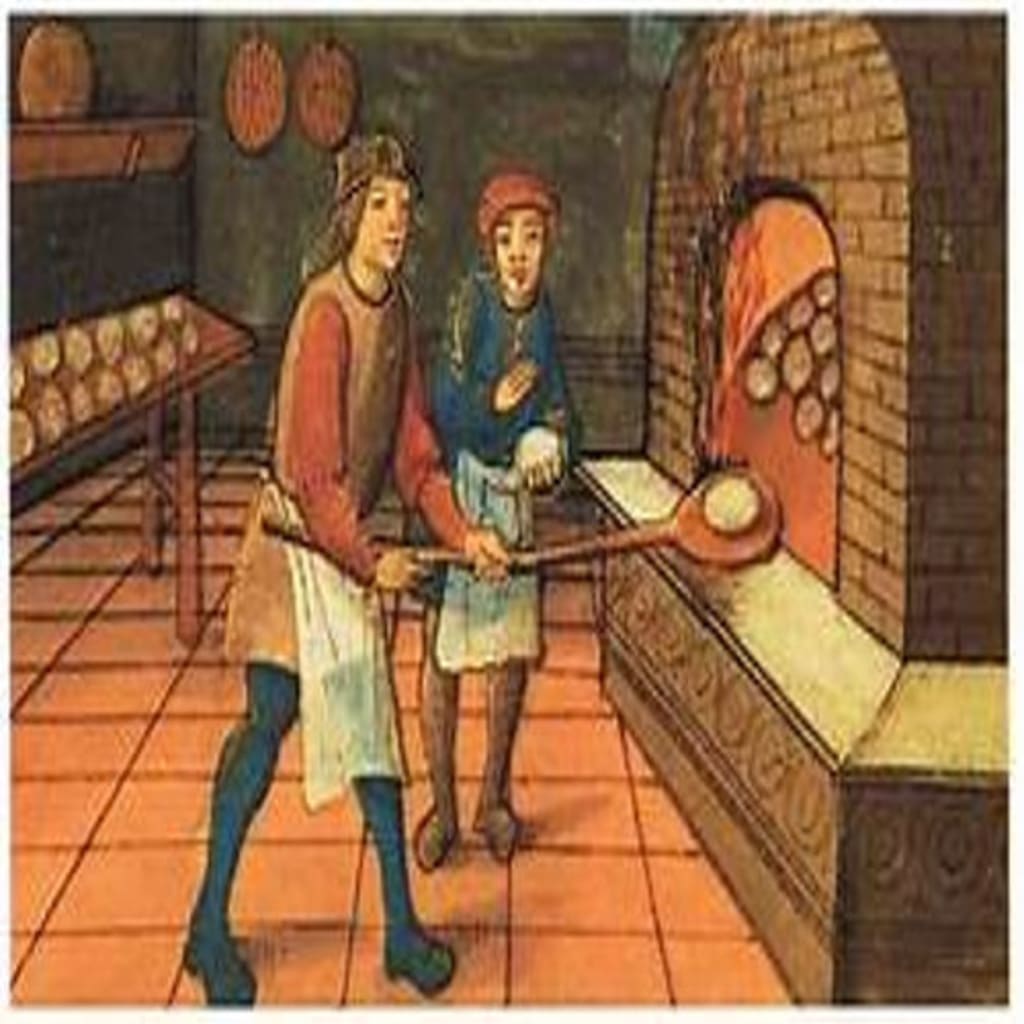
Partaking in the consumption of chips, Twinkies, and the convenience of a quick cheeseburger from a drive-thru may appear to be modern culinary institutions. However, the world's fascination with what we now term "junk food" has roots that stretch far back in history, reaching into the annals of antiquity. While today's fast-food industry is a massive global phenomenon, it might surprise you to learn that its humble beginnings can be traced back to medieval Europe. During this period, these gastronomic delights catered primarily to travelers and the less affluent segments of society, offering intriguing and sometimes unusual cuisine. In this exploration, we'll delve into the intriguing world of medieval junk food, shedding light on some of the culinary practices of the past. But before we embark on this historical journey, we invite you to subscribe to the Weird History channel. And please, don't hesitate to share your thoughts in the comments section below. If you have any other historical food topics you'd like us to explore, we're all ears. Now, let's transport ourselves back in time to the medieval era of fast food.
London, a city known today for its iconic landmarks, rich British culture, and bustling metropolis, was no less a center of trade and commerce during the Middle Ages. However, the era was characterized by widespread poverty, which created a stark contrast to the thriving commercial activities of the time. For many of the less fortunate denizens of London, the act of preparing meals at home was not only a matter of inconvenience but often an outright impossibility. Cooking equipment and fuel were luxuries that many simply couldn't afford.
Moreover, the impoverished residents of the city often inhabited tenement housing, a form of overcrowded urban housing that was devoid of basic furnishings, let alone a hearth for cooking. Without access to a hearth, the task of cooking became a nearly insurmountable challenge, as it would invariably fill their homes with smoke, risking both discomfort and the potential destruction of their already meager dwellings. As a result, the citizens of medieval London turned to cook shops as the practical solution to their culinary needs, effectively pioneering a precursor to the modern takeout restaurant.
These cook shops, reminiscent of the 24-hour fast-food establishments we have today, sprang up along the banks of the Thames River. They were open every day, adjusting their menus according to the seasonal availability of ingredients. However, the experience was quite different from our contemporary drive-thru service. Instead of riding through on horseback or in a carriage, customers would take a leisurely stroll up to these establishments to purchase their desired hot meals. Others opted to buy their food and then take it home to enjoy at their leisure, as consuming a plate of takeout in public was not always the preferred dining experience.
While cook shops were most prominent in London, they were by no means confined to this city alone. Bristol, another bustling medieval urban center, boasted its own "Cook's Row." These establishments offered an even wider variety of fare, which included poultry, fish, and more. Bristol's cook shops were early pioneers in the art of enticing customers through the power of aroma. They strategically positioned their cooking equipment outside the shop, ensuring that the alluring scent of their delectable dishes wafted through the streets, drawing passersby to partake in a quick and satisfying meal.
These cook shops served a diverse range of foods, catering to the varied tastes of their clientele. Some specialized in sweets, while others became renowned for their pancakes and bread. However, it's worth noting that among these medieval fast-food pioneers, the meat pie shops emerged as particularly popular establishments. These meat pies, while lacking the complexity and variety of today's fast-food burgers, bore a resemblance in the sense that they provided a portable, filling, and satisfying option for those on the go.
But let's not forget to explore the intriguing world of medieval meat pies in more depth.
As we venture further into the culinary landscape of the Middle Ages, we encounter meat pies, the forerunners of what we might consider today's drive-in hamburgers—albeit without the accompanying fries and cola. These savory treats were not only filling but also highly portable, which was a key characteristic of a blockbuster fast-food item, even in medieval times.
However, it's essential to note that these medieval meat pies were not without their peculiarities and challenges. One significant issue was the use of subpar or even spoiled meat. According to a 13th-century report from Norwich, cooks would often incorporate diseased pork into their pies and serve them to customers without hesitation. It wasn't uncommon for shop owners to reheat days-old pies, regardless of their state, rather than discarding them. The dire poverty of the time, coupled with a lack of concern for food safety, often made the decision to serve or discard expired food a disturbingly straightforward one.
Furthermore, shops would frequently undercook the meat, earning certain cooks a questionable reputation. The era saw the emergence of a saying that seemed to capture the sentiment well: "God sends the meat, but the devil sends the cooks." This perspective reflects the disillusionment of consumers who had experienced the less appetizing aspects of medieval meat pies.
The medieval period had its unique challenges when it came to ensuring the safety and quality of food, especially for those who frequented fast-food establishments of the time. Nonetheless, these medieval meat pies represented a crucial aspect of the era's culinary landscape and paved the way for the fast-food industry's evolution over the centuries.
Now that we've uncovered the secrets of medieval meat pies, let's journey further into the past to explore the various other forms of fast food that characterized the Middle Ages.
Bread, a dietary staple that remains essential even today, played a significant role in the culinary landscape of medieval Europe. However, in most households, access to grains and the means to process them into bread was limited, if not entirely unavailable. As a result, people turned to bakers to meet their bread needs. While selling pre-made loaves of bread was a straightforward business, medieval bakers offered their customers more than just that.
One intriguing service provided by medieval bakers involved the concept of "wrapping" meat in bread. Customers who brought their meat to the bakery could have it encased in a layer of bread and then baked to perfection. This ingenious solution allowed people to enjoy a convenient and delectable meal without the need for cooking facilities at home. To encourage this practice, London enacted a law in 1350 that prohibited bakers from charging more than a penny to wrap customers' meat in bread. This gesture aimed to make such offerings more affordable, catering to the needs of the less affluent members of society.
It's fascinating to note that a predecessor of the modern concept of fast food takeout began to take shape in medieval Europe. While medieval bakers primarily focused on bread production, their willingness to accommodate customer requests and the affordability of this service made it an early example of convenience dining in history.
Additionally, medieval Europeans pioneered the concept of the bread bowl, a culinary innovation that continues to thrive today. This ingenious idea involved serving soup and stews inside a hollowed-out loaf of bread, aptly known as a "trencher." These bread bowls not only added a unique twist to the dining experience but also contributed to the overall meal by providing an edible container. This practical approach helped reduce the need for dishes, making the consumption of soups and stews both convenient and economical
Soft pretzels, an iconic snack cherished by many today, were also incredibly popular in medieval Europe. Comprising just three simple ingredients—water, flour, and salt—these twisted treats made for a satisfying and portable snack. What's more, they received the official seal of approval from the Catholic Church. During fasting periods such as Lent, when Catholics refrained from consuming certain animal products, pretzels often took the place of those forbidden treats. Monks would distribute them to children reciting their prayers, and others would offer them to the less fortunate. Beyond their religious significance, pretzels became symbols of luck and prosperity in medieval Europe. There's nothing quite like munching on a handmade pretzel to make one feel fortunate.
When it comes to fast food indulgence, few things complement a meal better than a refreshing beverage, and medieval Europeans were no strangers to this concept. In fact, it's safe to say that they had a particular affinity for alcoholic beverages. Perhaps it was the challenging circumstances of medieval life that led to such widespread appreciation for libations, as it was a time of significant hardship for many.
One notable aspect of this penchant for alcohol was its resilience during periods of religious observance, such as Lent. While observing Lent meant abstaining from meat for some, others turned to alternative sources of nourishment. Some chose to substitute fish, but many opted for a more indulgent path: excessive drinking. Lent, with its intent of symbolizing abstinence and self-discipline, ironically became a time when people quenched their thirst for merriment and inebriation.
This devotion to alcohol during Lent drew criticism from prominent religious figures of the time. In 1400, the Benedictine Monk Robert Ripon expressed strong disapproval of excessive drinking during Lent. He argued that this practice contradicted the essence of abstinence that the period was meant to symbolize. In his view, people consumed more alcohol during Lent than they did throughout the rest of the year. However, one can't help but wonder if the good monk might have joined the revelry himself had he been faced with the alternative meat substitutes of the era, such as the "mock egg."
The concept of the "mock egg" is fascinating in its own right. This dish was invented as a meat replacement during Lent, a period of fasting and abstaining from certain foods, including meat. Making a mock egg was a relatively straightforward endeavor, even by today's standards. One would take empty eggshells, fill them with a mixture of almond milk, jelly, and crunchy almonds, dye them yellow for authenticity, and wash them down with a hearty mug of ale. The result might not have been the most delectable dish, but it certainly served its purpose during a time when dietary restrictions were rigidly observed.
As we explore the medieval culinary landscape further, we encounter an intriguing aspect of sweet treats during this period. Sugar, the ubiquitous sweetener that we take for granted today, was a rarity during medieval times, typically reserved for the privileged few who could afford it. As a result, medieval individuals sought alternatives to satisfy their sweet cravings, turning to honey as a primary source of sweetness.
One tantalizing medieval treat from the 14th century, sourced from the cookbook "Anonimo Veneziano," was a fritter made with apples, saffron, flour, and honey. This delightful combination of ingredients created a satisfying, sweet indulgence that captured the essence of medieval cuisine. Another, more frugal fritter recipe featured fried dough filled with ginger, almonds, and topped with a delectable beet juice—a creative and sweet way to enjoy a snack in the Middle Ages.
Another beloved item that catered to the medieval sweet tooth was gingerbread, which featured prominently in the culinary landscape of the time. This delightful treat combined honey with ginger, cloves, and pepper, resulting in a unique blend of sweet and spicy flavors. Gingerbread became a favorite among those seeking a sweet escape from the challenges of medieval life.
However, if one were in the mood for indulging in a cholesterol spike and was willing to splurge, there was nothing quite like the beloved funnel cake. This delightful concoction, a fusion of fried dough and powdered sugar, has long held a special place in the hearts of carnival-goers. Yet, its origins trace back to medieval times when it began as a fried cake called "crisps." Due to the scarcity of ingredients like sugar, these cakes were a rare treat. As a result, people often improvised their own recipes, leading to the creation of dishes like the "fritter of milk," which was essentially fried, sweetened cottage cheese—a dessert that might strike fear into the hearts of modern children.
Waffles, as we know them today, also have their origins in medieval Europe. The original waffles, dating back to ancient Greece and known as "obelios," were flat cakes cooked between two plates. However, they lacked the sweet touch that we associate with waffles today, a glaring omission that may have contributed to Greece's downfall.
In a historical twist, the Catholic Church became involved in the production of flour wafers, which often featured biblical scenes. However, it wasn't until the era of the Crusades that a more recognizable version of waffle batter, combining cinnamon, honey, and cream, gained popularity in Europe. It was in the 15th century that the Dutch introduced the iconic grid patterns we associate with waffles, turning them into optimal vessels for syrup and whipped cream—a delight for junk food enthusiasts across the centuries.
Originally sold as street food, waffles eventually evolved into the breakfast and dessert staple that we still enjoy today. Thanks to the discovery of the New World, sugar gradually became more affordable and accessible to people from all walks of life by the 16th century. London even witnessed the opening of a sugar refinery, heralding a trend in food processing that continues to this day—adding sugar to nearly everything.
The introduction of sugar transformed the European diet in remarkable ways. Honey, once the primary source of sweetness, began to take a back seat as sugar made its triumphant entrance into the culinary scene. People started crystallizing their fruits and syrups, incorporating sugar into the seasoning of their meats, and exploring an array of sugary concoctions. These treats, sweetened by honey, included crispy crusts topped with berries, fruits, or ginger and a delightful fruit-filled ravioli known as "Cuskynoles," a name that possesses a certain charm that wouldn't be out of place on a Hostess wrapper alongside a Cuskynoles mascot.
The European penchant for sweetness during this period was so profound that it even left its mark on the language. The word "dessert" as we know it today can be traced back to this time. Derived from the French word "desservir," meaning "to clear the table," the French used it to refer to the final course of a meal by the mid-16th century. English speakers later adopted "dessert" to describe the concluding course of fruits and sweets consumed after the main meal. The Cuskynoles mascot would indeed be proud of its role in shaping the language.
Now that we've explored the rich tapestry of medieval junk food, it's time to reflect on the question: Would you be willing to try some of these culinary delights from the Dark Ages?





Comments (1)
Interesting read